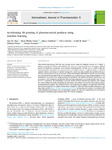| dc.contributor.author | Ong, Jun Jie | |
| dc.contributor.author | Muñiz, Brais | |
| dc.contributor.author | Gaisford, Simon | |
| dc.contributor.author | Cabalar, Pedro | |
| dc.contributor.author | Basit, Abdul W | |
| dc.contributor.author | Pérez, Gilberto | |
| dc.contributor.author | Goyanes, Álvaro | |
| dc.date.accessioned | 2022-09-05T17:02:52Z | |
| dc.date.available | 2022-09-05T17:02:52Z | |
| dc.date.issued | 2022 | |
| dc.identifier.citation | ONG, Jun Jie, CASTRO, Brais Muñiz, GAISFORD, Simon, CABALAR, Pedro, BASIT, Abdul W., PÉREZ, Gilberto and GOYANES, Alvaro, 2022. Accelerating 3D printing of pharmaceutical products using machine learning. International Journal of Pharmaceutics: X. 1 December 2022. Vol. 4, p. 100120. DOI 10.1016/j.ijpx.2022.100120. | es_ES |
| dc.identifier.uri | http://hdl.handle.net/2183/31493 | |
| dc.description.abstract | [Abstract] Three-dimensional printing (3DP) has seen growing interest within the healthcare industry for its ability to fabricate personalized medicines and medical devices. However, it may be burdened by the lengthy empirical process of formulation development. Active research in pharmaceutical 3DP has led to a wealth of data that machine learning could utilize to provide predictions of formulation outcomes. A balanced dataset is critical for optimal predictive performance of machine learning (ML) models, but data available from published literature often only include positive results. In this study, in-house and literature-mined data on hot melt extrusion (HME) and fused deposition modeling (FDM) 3DP formulations were combined to give a more balanced dataset of 1594 formulations. The optimized ML models predicted the printability and filament mechanical characteristics with an accuracy of 84%, and predicted HME and FDM processing temperatures with a mean absolute error of 5.5 °C and 8.4 °C, respectively. The performance of these ML models was better than previous iterations with a smaller and a more imbalanced dataset, highlighting the importance of providing a structured and heterogeneous dataset for optimal ML performance. The optimized models were integrated in an updated web-application, M3DISEEN, that provides predictions on filament characteristics, printability, HME and FDM processing temperatures, and drug release profiles (https://m3diseen.com/predictionsFDM/). By simulating the workflow of preparing FDM-printed pharmaceutical products, the web-application expedites the otherwise empirical process of formulation development, facilitating higher pharmaceutical 3DP research throughput. | es_ES |
| dc.language.iso | eng | es_ES |
| dc.publisher | Elsevier | es_ES |
| dc.relation.uri | https://doi.org/10.1016/j.ijpx.2022.100120 | es_ES |
| dc.rights | Atribución 3.0 España | es_ES |
| dc.rights.uri | http://creativecommons.org/licenses/by/3.0/es/ | * |
| dc.subject | Additive manufacturing of pharmaceuticals | es_ES |
| dc.subject | Manufacture of medicinal products | es_ES |
| dc.subject | Fused filament fabrication and Fused deposition modelling | es_ES |
| dc.subject | 3D printed drug products and medicines | es_ES |
| dc.subject | Printing medical devices and implants | es_ES |
| dc.subject | Artificial intelligence and digital health | es_ES |
| dc.subject | Material extrusion and drug delivery systems | es_ES |
| dc.title | Accelerating 3D printing of pharmaceutical products using machine learning | es_ES |
| dc.type | info:eu-repo/semantics/article | es_ES |
| dc.rights.access | info:eu-repo/semantics/openAccess | es_ES |
| UDC.journalTitle | International Journal of Pharmaceutics: X | es_ES |
| UDC.volume | 4 | es_ES |
| UDC.startPage | International Journal of Pharmaceutics: X | es_ES |
| dc.identifier.doi | 10.1016/j.ijpx.2022.100120 | |






